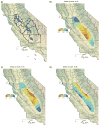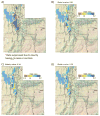Spatial analysis of gastroschisis in the National Birth Defects Prevention Study
- PMID: 25850424
- PMCID: PMC4478213
- DOI: 10.1002/bdra.23375
Spatial analysis of gastroschisis in the National Birth Defects Prevention Study
Abstract
Background: Gastroschisis is a birth defect where loops of bowel are protruding from the abdominal wall at birth. Previous research has suggested that gastroschisis cases can occur in clusters. The objective of this study was to identify if there were areas of elevated gastroschisis risk using data from the National Birth Defects Prevention Study (NBDPS), 1997 through 2007.
Methods: We obtained data on cases (n = 371) through population-based birth defects surveillance systems in Arkansas, California, and Utah; controls (n = 2359) were selected from the same geographic areas as cases. Mothers were interviewed on demographic information and exposures during pregnancy, including residential history. We used first trimester maternal addresses and generalized additive models to create a continuous map surface of odds ratios (OR) by smoothing over latitude and longitude. Permutation tests were used to assess whether location of maternal residence was important and identify locations with statistically significant ORs.
Results: In Arkansas, adjusted ORs in the southwest corner were 2.0 and the global deviance was not statistically significant (p-value: 0.57). Adjusted ORs for California indicated areas of increased risk with ORs 1.3 (p-value: 0.34). In Utah, the adjusted ORs were elevated (OR: 2.4) in the south-eastern corner of the study area (p-value: 0.34).
Conclusion: The results of this study, while not statistically significant, suggest there were spatial variations in gastroschisis births. We cannot rule out that these variations were due to edge effects or residual confounding.
Keywords: congenital abnormalities; gastroschisis; spatial analysis.
© 2015 Wiley Periodicals, Inc.
Figures



References
-
- Agopian A, Langlois PH, Cai Y, Canfield MA, Lupo PJ. Maternal residential atrazine exposure and gastroschisis by maternal age. Matern Child Health J. 2013;17(10):1768–1775. - PubMed
-
- Alvarez SM, Burd RS. Increasing prevalence of gastroschis repairs in the United States: 1996–2003. J Pediatr Surg. 2007;42(6):943–946. - PubMed
-
- Bugge M, Petersen MB, Christensen MF. Monozygotic twins discordant for gastroschisis: case report and review of the literature of twins and familial occurrence of gastroschisis. Am J Med Genet. 1994;52(2):223–226. - PubMed
-
- Canfield MA, Honein MA, Yuskiv N, Xing J, Mai CT, Collins JS, Devine O, Petrini J, Ramadhani TA, Hobbs CA, Kirby RS. National estimates and race/ethnic-specific variation of selected birth defects in the United States, 1999–2001. Birt Defects Res A Clin Mol Teratol. 2006;76(11):747–756. - PubMed
-
- Canfield MA, Ramadhani TA, Shaw GM, Carmichael SL, Waller DK, Mosley BS, Royle MH, Olney RS. Anencephaly and spina bifida among Hispanics: maternal, sociodemographic, and acculturation factors in the National Birth Defects Prevention Study. Birt Defects Res A Clin Mol Teratol. 2009;85(7):637–646. - PubMed
Publication types
MeSH terms
Grants and funding
LinkOut - more resources
Full Text Sources
Other Literature Sources

